Diplomatic Bluebook 2015
Chapter 2
Japan’s Foreign Policy that Takes a Panoramic Perspective of the World Map
2.China and Mongolia, etc.
(1) China
A. Situation in China
(a) Economy
In 2014, China’s nominal GDP totaled 63.6 trillion yuan, while its real GDP growth rate was 7.4% (the target set by the Government of China for the real GDP growth rate was around 7.5%).
With the pace of China’s economic expansion slowing down, the Government of China took steps to shore up the economy, including increasing tax incentives for small and medium-sized enterprises (SMEs) (April 2014) and reducing the bank rate (November 2014).
At the Central Economic Work Conference in December, Chinese leaders pointed out that the Chinese economy was currently in a transition phase to a “new normal,” moving from high growth to medium-to-high growth and from quantitative expansion to qualitative development/improvement. Specific changes cited included the diversification of consumption, the saturation of traditional industries, a reduction in international competitiveness due to rising labor costs, oversupply, and a decrease in the workforce due to the aging of the population. Chinese leaders then stressed the importance of greater emphasis on the market in economic policy, the promotion of structural reform, and innovation in adapting to the “new normal.” They affirmed that in 2015, they would continue to implement the policies of “making progress while ensuring stability” and “proactive fiscal and prudent monetary policies.”
Moreover, at an executive meeting of the State Council in December, Chinese leaders decided to establish pilot free trade zones in Tianjin, Fujian, and Guangdong, to build on the achievements of the China (Shanghai) Pilot Free Trade Zone, a trial project that was established in 2013 to attract foreign investment by easing restrictions on finance and investment within the zone.
2015 marks the final year of the 12th Five-Year Plan, so attention will focus on the degree to which China can move forward with reforms of its economic system, while maintaining a certain level of economic growth.
(b) Domestic affairs
In March 2014, the 2nd Plenary Session of the 12th National People’s Congress was held in Beijing. Following the adoption of basic policies for reform at the Third Plenary Session of the 18th Central Committee of the Communist Party of China (Third Plenum) the previous fall, Premier Li Keqiang announced in the Report on the Work of the Government his powerful resolve to pursue reform, using such expressions as “great determination” and “break...vested interests.”
In October, the Fourth Plenary Session of the 18th Central Committee of the Communist Party of China (Fourth Plenum) was held in Beijing. The Plenum adopted the “Decision on Major Issues Concerning Comprehensively Deepening Rule of Law”, emphasizing that China will aim to achieve the “rule of law with Chinese characteristics” while maintaining the principle of “leadership by the Communist Party of China (CPC).”
To date, Xi Jinping and his leadership team have repeatedly voiced their alarm about rampant corruption within China, and numerous corrupt senior officials within the party, government, and state-owned enterprises have been exposed. In March 2014, the Chinese authorities decided to investigate Xu Caihou (former Vice Chairman of the Central Military Commission). In June, he was expelled from the party for serious breaches of discipline and prosecutors decided to file a case with judicial authorities on charges of bribery.
Reports that Zhou Yongkang (formerly a member of the Central Politburo Standing Committee under the leadership of Hu Jintao, with authority over security and law enforcement) was under house arrest emerged as early as December 2013; at the end of July 2014, the Central Commission for Discipline Inspection decided to investigate him with a view to bringing a case against him. Moreover, in December, the CPC Central Committee decided to expel him from the party and to file a case with judicial authorities on the grounds of violating “the Party’s political discipline,” taking large sums in bribes, abuse of power, leaking state and party secrets, and involvement in prostitution.
In terms of the social climate, Chinese human rights lawyers and intellectuals were detained ahead of the 25th anniversary of the Tiananmen Square incident on June 4. In addition, ethnic Uyghurs were responsible for attacks that caused indiscriminate casualties near Kunming Station in Yunnan Province (March) and in Kashgar in the Xinjiang Uyghur Autonomous Region (July), and a bombing occurred in the autonomous region’s Bayingolin Mongol Autonomous Prefecture in September.
In Hong Kong, criticizing the decision taken at the end of August by China’s National People’s Congress concerning reforms of the system for electing Hong Kong’s chief executive as effectively making it impossible for pro-democracy candidates to stand, students and pro-democracy groups began a protest (“Occupy Central”) at the end of September, occupying major thoroughfares for two and a half months.
(c) Foreign policy
Although tensions emerged in China’s relationships with neighboring countries over the South China Sea in 2014, it demonstrated a noticeably proactive approach on the diplomatic front, holding large international conferences such as the Conference on Interaction and Confidence-Building Measures in Asia (CICA) Summit and the APEC Economic Leaders’ Meeting, and making moves toward the establishment of the Asian Infrastructure Investment Bank (AIIB).
In May, China hosted the CICA Summit in Shanghai; in his keynote address, President Xi Jinping described his vision for “common, comprehensive, cooperative and sustainable security” and presented the concept of “security in Asia that is ultimately safeguarded by all people of Asia.”
In July, President Xi attended the BRICS Summit in Brazil and expressed his wish that the BRICS Development Bank, whose establishment was agreed at the summit, be based in Shanghai. In October, a ceremony was held in Beijing for the signing of the Memorandum of Understanding (MOU) on Establishing the AIIB, which had been advocated by President Xi.
On the other hand, developments that caused tensions with neighboring countries included a confrontation at sea between Vietnamese and Chinese vessels in May, which stemmed from China’s oil drilling activities near the Paracel Islands in the South China Sea. In addition, following the 2013 initiation of arbitration proceedings by the Government of the Philippines over the South China Sea, the Government of China published a position paper in December 2014, stating that it did not accept the arbitration and would not participate in it.
In November, China hosted the APEC Economic Leaders’ Meeting in Beijing, where the “Beijing Declaration on Fighting Corruption” was adopted at China’s own initiative. Moreover, at the U.S.–China summit held after the APEC meeting ended, the two countries agreed on two measures as a confidence-building mechanism between their respective defense authorities, as well as together announcing numerical targets for the reduction of greenhouse gas emissions.
At the end of November, after all of 2014’s major diplomatic events had ended, the Central Conference on Work Relating to Foreign Affairs was held in Beijing. In his important address to the conference, President Xi said, “China should develop a distinctive diplomatic approach befitting its role of a major country,” stating that China should “stick to our development path, social system, cultural tradition and values.”
(d) Military and security affairs
China continues to increase its already-high defense expenditure, with the 2014 national defense budget growing by 12.2% (2014 budget figure) compared with actual expenditure the previous year. At the same time, although the intention behind the increase is unclear, as no explanation has been provided in the form of a detailed breakdown of expenditure, it is believed to be extensively and rapidly bolstering its military capacity, with a primary focus on nuclear and missile capabilities, as well as its navy and air force. More specifically, in 2012, the Chinese Ministry of National Defense officially announced the commissioning of its Liaoning aircraft carrier, and there is also information to suggest that it is currently building a domestically produced aircraft carrier.
Moreover, China is continuing its unilateral attempts to change the status quo, by such means as the November 2013 establishment of the Air Defense Identification Zone (ADIZ) in the East China Sea, as well as incidents in May and June 2014, in which Chinese military aircraft approached Self-Defense Forces (SDF) aircraft. Since such actions are a matter of common concern within the region, Japan intends to work in partnership with relevant countries to ensure that China acts within the framework of international order based on the rule of law.
B. Japan–China Relations
(a)The situation surrounding Japan–China relations
Japan and China are neighbors across the East China Sea. They have an inseparable relationship characterized by close economic relations and people-to-people and cultural exchanges. At the same time, they have numerous political and social differences, so friction and disputes inevitably arise between them on occasion, precisely because they are neighbors. Based on the attitude that individual points of contention should not be allowed to affect their relationship as a whole, Japan and China agreed in 2006 on building a “Mutually Beneficial Relationship based on Common Strategic Interests.” Since then, the leaders of the two countries have repeatedly affirmed that they will promote a “Mutually Beneficial Relationship based on Common Strategic Interests.”
2014 was a year in which numerous initiatives were undertaken to improve Japan–China relations. In May, the Japan–China Parliamentarians’ Friendship League visited China and held talks with Zhang Dejiang, Chairman of the National People’s Congress. Thereafter, the number of key figures traveling between the two countries increased, primarily for the purpose of exchange among parliamentarians. Also in May, Minister of Economy, Trade and Industry Toshimitsu Motegi visited China to attend the APEC Meeting of Ministers Responsible for Trade, during which he held talks with Chinese Minister of Commerce Gao Hucheng. In June, Minister of Land, Infrastructure and Transport Akihiro Ota visited China and held talks with Vice Premier Liu Yandong. An informal meeting of the new 21st Century Committee for Japan-China Friendship was held in Nagasaki in the same month, attended by a delegation of Chinese members led by Tang Jiaxuan, President of the China-Japan Friendship Association. A candid and constructive discussion of various outstanding issues of concern to Japan and China took place at the meeting.
Amid these various exchanges and dialogues, the two countries took the opportunity presented by the ASEAN Foreign Ministerial Meeting and related meetings in Myanmar in August to hold an informal meeting between foreign ministers Fumio Kishida and Wang Yi. A similar informal meeting between the foreign ministers of Japan and China took place during the UN General Assembly session in September and positive progress was made in improving relations between the two countries.
On November 7, the governments of Japan and China issued a statement entitled “Regarding Discussions toward Improving Japan–China Relations” and, when the APEC Ministerial Meeting was held in Beijing the following day, the Japan–China Foreign Ministers’ Meeting took place for the first time in around 26 months. On November 10, during the APEC Economic Leaders’ Meeting, the Japan–China Summit Meeting was held for the first time in approximately two and a half years. These talks were the first step toward returning the relationship between the two countries to the starting point of a “Mutually Beneficial Relationship based on Common Strategic Interests” and improving relations further.
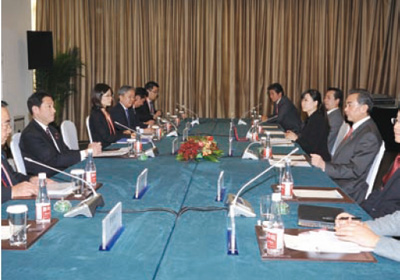 The Japan–China Foreign Ministers’ Meeting (November, Beijing)
The Japan–China Foreign Ministers’ Meeting (November, Beijing)
Nevertheless, Chinese government vessels continued to make incursions into Japanese territorial waters around the Senkaku Islands, even after the Japan–China Summit Meeting. The first incursion by Chinese government vessels into Japanese territorial waters off the Senkaku Islands took place in December 2008, and China made repeated incursions into Japanese territorial waters in 2014, sending government vessels into the waters surrounding the Senkaku Islands 32 times over the course of the year (88 vessels in total).
The Senkaku Islands are indisputably an inherent part of the territory of Japan in light of historical facts and based upon international law. Indeed, the Senkaku Islands are under the valid control of Japan. Consequently, there exists no issue of territorial sovereignty to be resolved concerning the Senkaku Islands. Since 1885, Japan conducted repeated investigations and, having confirmed that there were no traces to suggest that the islands were under the control of the Qing dynasty, incorporated them into Japanese territory in January 1895. Subsequently, with the permission of the Government of Japan, numerous Japanese citizens settled on the Senkaku Islands, where they engaged in business activities such as the manufacture of dried bonito flakes. After World War II, the Senkaku Islands were placed under the administration of the U.S. by the San Francisco Peace Treaty.
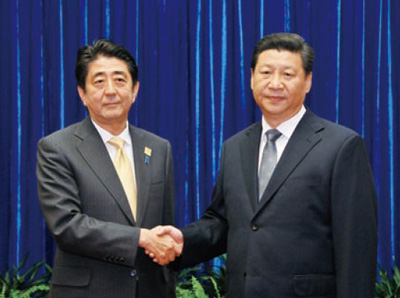 Prime Minister Abe and President Xi shake hands at the Japan–China Summit Meeting (November 10, Beijing; Source: Cabinet Public Relations Office)
Prime Minister Abe and President Xi shake hands at the Japan–China Summit Meeting (November 10, Beijing; Source: Cabinet Public Relations Office)
From 1895, when Japan obtained territorial title over the Senkaku Islands by lawful means under international law, until the 1970s, when the islands became the focus of attention after it was suggested that there might be oil reserves in the East China Sea, China did not raise any objections to Japan’s sovereignty over the Senkaku Islands1. Moreover, China has never explained why it did not contest Japan’s sovereignty over the islands.
The Government of Japan will continue to deal with the situation with resolute determination to defend Japan’s territorial land, sea, and airspace. We have repeatedly used diplomatic channels to lodge strong protests and request the withdrawal of Chinese vessels. In May and June, there were incidents in which Chinese military aircraft approached SDF aircraft. Japan strongly urged China not to engage again in such dangerous acts, which could lead to an accident.
Japan has urged China to swiftly start the operation of a maritime communication mechanism without delay, in order to avoid unforeseen consequences. In September, the second round meeting of the Japan–China High-Level Consultation on Maritime Affairs took place and the two sides reached a shared view in principle to resume consultations for the early implementation of a maritime communication mechanism between the defense authorities of the two countries. In addition, the leaders of the two countries confirmed at the Japan–China Summit Meeting that working-level discussions would continue.
Japan and China share responsibility for the peace and stability of the region and the entire international community. Stable Japan–China relations are essential not only to the citizens of both countries, but also to the peace and stability of the Asia-Pacific region as a whole. Accordingly, based on the concept of the “Mutually Beneficial Relationship based on Common Strategic Interests,” the Government of Japan will promote the development of Japan–China relations from a broad perspective through continued dialogues and cooperation at various levels.
- 1 Chinese documents compiled in the 1950s and 1960s have been found that show the Senkaku Islands as part of Japanese territory. For example, MOFA has published on its website a map published in China in 1969, which marks the Senkaku Islands as Japanese territory and appears to have been compiled on the premise that the Senkaku Islands are Japanese territory
[http://www.mofa.go.jp/mofaj/area/senkaku/pdfs/senkaku_pdf].
(b)The issue of Chinese coral vessels in the seas close to Japan, including around the Ogasawara Islands
Since mid-September 2014, many vessels believed to be Chinese coral vessels morefound in the seas close to Japan, including around the Ogasawara Islands. In light of the fact that they operated illegally, the Government of Japan raised largely the maximum fine for illegal operations by foreign fishing vessels, in order to maximize the deterrent effect of the fine. In addition, the Fisheries Agency, the Japan Coast Guard, and other relevant ministries and agencies worked together to strengthen efforts to crack down on foreign fishing vessels, including by implementing measures via the supplementary budget. In addition, Japan repeatedly expressed its concerns to China via diplomatic channels, requesting that steps be taken to prevent recurrence. At the Japan–China Foreign Ministers’ Meeting on November 8, Foreign Minister Kishida expressed concern over the matter and stated that it is important to enhance the effectiveness of controls in China and that he wants to strengthen cooperation between the relevant authorities of the two countries. In response, Foreign Minister Wang Yi announced that China is also taking the necessary measures. Moreover, at the 15th Japan–China Joint Committee on Fisheries held in Dalian in December, the two sides agreed that Japan and China would continue to enforce a staunch crackdown and would strengthen all possible measures to eradicate poaching by Chinese coral vessels, including severe penalties for offenders.
(c) Japan–China economic relations
Japan and China maintain close and mutually dependent economic relations in such areas as trade and investment. The value of trade between the two countries (excluding Hong Kong) in 2014 was approximately 309.2 billion US dollars and China retained its status as Japan’s biggest trading partner for the eighth consecutive year. In addition, according to Chinese statistics, Japan was China’s second-largest source of foreign direct investment (approximately 4.33 billion US dollars in 2014).
Amid the tensions that have beset Japan–China relations since 2012, Japanese direct investment in China fell by 38.8% in 2014 compared with the previous year, due also in part to domestic factors such as the rise in labor costs in China. However, exchange and dialogue in economic fields have continued and Ministerial-level dialogue aimed at a rapprochement has resumed. Moreover, exchange at the private sector level has been flourishing, with visits being made to China by delegations from such groups as the Japan Association of Corporate Executives and the Japan-China Economic Association. At the end of December, the Japan–China Energy Conservation Forum, which involves members of the public and private sectors in both Japan and China, took place in Beijing for the first time in two years, and was attended by State Minister of Economy, Trade and Industry Yosuke Takagi. At this forum, Japanese and Chinese participants exchanged opinions on a wide range of subjects relating to energy conservation and the environment, and agreements on various cooperation projects were signed.
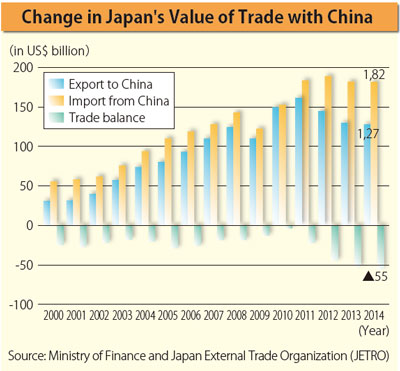

The issue of the use of chicken that was past its use-by date, which broke out in China in July, also attracted considerable attention in Japan. In August, a working-level meeting under the Japan-China Food Safety Promotion Initiative was held in Beijing on this matter. The Japanese contingent asked the Chinese representatives to find out the truth without delay, and the two sides engaged in a frank exchange of opinions concerning the measures required to ensure food security.
At the 15th Japan–China Joint Committee on Fisheries in December, the two sides discussed the issue of Chinese coral vessels and agreed on specific measures to preserve and manage resources in the East China Sea.
(d) Promoting mutual understanding at the private sector level
a.Current state of people-to-people exchanges between Japan and China
A total of approximately 5.13 million people engaged in people-to-people exchanges between Japan and China in 2014 (with around 2.41 million people visiting Japan and around 2.72 million visiting China). While the number of visitors to Japan increased by around 1.09 million (+82.6% from the previous year), reaching the highest level ever, the number of visitors to China fell by around 160,000 (-5.6% from the previous year).
b.Youth exchange between Japan and China
In 2014, around 1,500 Chinese young people, including high school and university students, were invited to Japan under JENESYS 2.0. As well as gaining first-hand experience of Japanese culture and life through various exchanges and tours, the Chinese young people who visited Japan had the opportunity to meet with Japanese youngsters, gaining a deeper understanding of each other and engaging in a lively exchange of views concerning such matters as the future shape of Japan–China relations.
c. Exchange in various fields
A diverse array of people from a variety of levels and fields from China have been invited to Japan, with the aim of building and strengthening a wide range of relationships. These include central and local government leaders, people with a degree of influence in the worlds of government, business, the public sector, and academia, the leaders of the future, and opinion leaders. These exchanges have helped to build good relations between the visitors and relevant Japanese figures, as well as promoting an accurate understanding of Japan.
d.The New 21st Century Committee for Japan-China Friendship
The new 21st Century Committee for Japan-China Friendship was established to enable experts from Japan and China to engage in wide-ranging discussions and provide the heads of government of both countries with proposals and reports, in order to further develop Japan–China relations in the 21st century (Japanese chairman: Taizo Nishimuro, Advisor, Toshiba Corporation; President and CEO, Japan Post Holdings Co., Ltd. Chinese chairman: Tang Jiaxuan, former State Counselor). In 2014, the committee held an informal meeting in Nagasaki in June, followed by its fourth formal meeting in China (Beijing and Xi’an) in December (the first formal meeting for around 38 months). At the meetings, participants engaged in a frank and lively discussion concerning such matters as the improvement and development of Japan–China relations, and together acknowledged the importance of improving popular sentiment in both countries and ensuring cooperation between Japan and China in a wide range of fields.
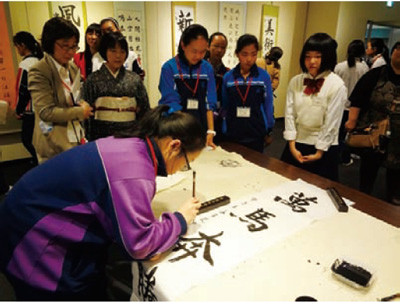 An exhibition of calligraphy by Japanese and Chinese students (April 13; Source: Japan–China Friendship Center)
An exhibition of calligraphy by Japanese and Chinese students (April 13; Source: Japan–China Friendship Center)
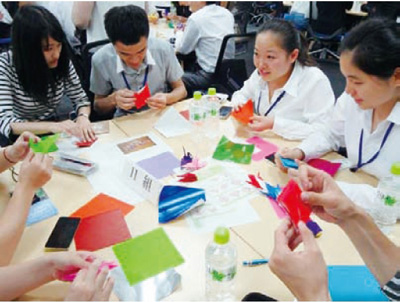 Kanazawa University students get to know university students from China (June 20; Source: Japan–China Friendship Center)
Kanazawa University students get to know university students from China (June 20; Source: Japan–China Friendship Center)
(e) The issue of abandoned chemical weapons
Based on the Chemical Weapons Convention (CWC), the Government of Japan has been undertaking the destruction of abandoned chemical weapons in China. Mobile destruction facilities are being used to destroy such weapons in Shijiazhuang, Hebei Province and Wuhan, Hubei Province. In addition, test destruction operation began in December 2014 at Haerbaling, Dunhua City Jilin Province, where the largest number of abandoned chemical weapons is buried. Steady progress is being made in the destruction of these abandoned chemical weapons, with approximately 38,000 having been destroyed by the end of 20142.
- 2 Approximately 52,000 chemical weapons belonging to the Imperial Japanese Army that were abandoned in China have been discovered to date over an extensive area ranging from Heilongjiang Province in the north to Guangdong Province in the south. In addition, it is estimated that between approximately 300,000 and 400,000 such weapons are buried at Haerbaling, Dunhua City Jilin Province. As well as conducting joint surveys with the Chinese authorities, the Government of Japan is undertaking excavation and recovery projects in each region and destroying the weapons discovered, with the cooperation of the Government of China.
(2) Taiwan
A. Internal Affairs
The approval ratings of the administration of Ma Ying-jeou, which entered the third year of its second term in May 2014, continued to fall and the Kuomintang lost many important posts in the large-scale local elections held on November 29. The Cabinet resigned en masse to take responsibility, while President Ma Ying-jeou resigned as Chairman of the Kuomintang.
The economy is gradually recovering and the real GDP growth rate rose 3.74% against the previous year in 2014 (preliminary results), due in part to domestic demand in the form of private sector consumption and fixed capital investment.
B. Cross-Strait Relations and Foreign Affairs
Cross-strait relations improved rapidly after Ma Ying-jeou’s administration came to power in 2008. Previously, this improvement was primarily focused on economic relations, as represented by the Economic Cooperation Framework Agreement (ECFA), but new developments was seen in 2014, such as the visit to China by Wang Yu-chi, Minister of Taiwan’s Mainland Affairs Council, in February and the visit to Taiwan by Zhang Zhijun, Minister of the Taiwan Affairs Office of China’s State Council, in June. On the other hand, opposition to cross-strait rapprochement was seen, with Taiwanese students and other citizens opposed to the Cross-Strait Service Trade Agreement occupying the Legislative Yuan from March to April.
C. Japan–Taiwan Relations
The relationship between Japan and Taiwan is maintained on the basis of working relations at the non-governmental level, in accordance with the 1972 Joint Communiqué between Japan and China. For Japan, Taiwan is a crucial partner and an important friend, with which it shares basic values in the form of freedom, democracy, basic human rights, and the rule of law, as well as close economic relations (Taiwan is Japan’s fifth-largest trading partner, while Japan is Taiwan’s second-largest trading partner) and people-to-people exchanges (the number of short-term visitors traveling between Japan and Taiwan reached an all-time high of approximately 4.4 million in 2014).
Against this background, working relations between Japan and Taiwan are deepening and in 2014, the Interchange Association, and the Association of East Asian Relations signed cooperation arrangements covering a variety of fields, including the development of tourism initiatives and the peaceful use of nuclear energy. Moreover, in June, the two associations set up the Japan–Taiwan Economic Partnership Committee, a framework for cross-cutting discussion of economic relations between Japan and Taiwan.
Cultural exchanges between Japan and Taiwan are also flourishing: a special exhibition of items from the Palace Museum was held from June 24 until September 15 at the Tokyo National Museum and from October 7 until November 30 at the Kyushu National Museum, and was very well received.
Taiwan also asserts its own claim to the Senkaku Islands and there have been moves by civilian activists to land on the islands, as well as cases in which vessels belonging to the Taiwanese authorities have passed through the waters surrounding the Senkaku Islands. However, none of these situations have escalated to the extent where they affect Japan–Taiwan relations in general.
(3) Mongolia
A. Domestic Affairs
In October 2014, the opposition Mongolian People’s Party submitted a resolution demanding the dismissal of Prime Minister Norov Altankhuyag on the grounds of economic mismanagement by the Altankhuyag administration, among other reasons. Supported by some influential members of parliament from the Democratic Party, the resolution was passed and the Altankhuyag Cabinet resigned en masse in November. Chimed Saikhanbileg, who served as Cabinet Secretary in the Altankhuyag Cabinet, was appointed to succeed him as Prime Minister. The main ruling party, the Democratic Party held talks with all of the political parties with seats in the parliament and decided to form a cabinet via a grand coalition that also includes the Mongolian People’s Party, the largest opposition party. The structure of the government was reorganized into 15 ministries and 19 ministers, and the Saikhanbileg Cabinet was inaugurated in December. In his policy speech, acknowledging the critical situation facing the Mongolian economy, Prime Minister Saikhanbileg announced policies that put the economy first and stated that he aimed to create “a government that can make decisions quickly.”
Having experienced double-digit GDP growth for several years, reaching a growth rate of 17.3% in 2011, the Mongolian economy has slowed in response to a slump in resource prices and a fall in foreign direct investment. The economic growth rate in 2014 was 7.8% (preliminary results published by the National Statistical Office of Mongolia).
B. Japan–Mongolia Relations
Japan aims to continue to develop friendly relations with Mongolia, with which it shares fundamental values in the form of freedom and democracy, as well as a market economy.
High-level exchanges continued to flourish in 2014, following on the previous year. Including telephone talks, Prime Minister Abe and President Tsakhiagiin Elbegdorj held talks on four occasions in 2014. In particular, at the summit that took place in July when President Elbegdorj visited Japan to attend the Mongolia–Japan Business Forum co-hosted by the Japan Business Federation (Keidanren) and the Government of Mongolia, the two leaders announced that they had reached an agreement in principle of the negotiations concerning the Japan–Mongolia Economic Partnership Agreement (EPA) and agreed on the importance of strengthening cooperation in the field of the economy, in order to further reinforce their Strategic Partnership. Moreover, as well as proposing the “ERCH Initiative Plus” to promote Mongolian exports and industrial diversification, Prime Minister Abe announced his intention to provide Mongolia with assistance in formulating medium- to long-term economic policy through support measures including the dispatch of economic advisers, in response to a request from the Mongolian side.
Furthermore, the Japan–Mongolia Mid-term Action Plan for a Strategic Partnership formulated in 2013 is being steadily implemented, with multilevel dialogue taking place between the diplomatic authorities of both countries. As well as the Foreign Ministers’ Meeting between Fumio Kishida and Luvsanvandan Bold that took place at the ASEAN Foreign Ministerial Meeting and related meetings in August, the First Japan–Mongolia Strategic Dialogue took place at the vice-ministerial level in Tokyo in June, while the Second Japan–Mongolia Politico-Military Consultations was held in December.
